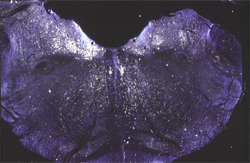Blah Blah Blah
Navigation: Mission :: Researchers ± :: Projects ± :: Meetings :: Progress :: Download

We are a diverse group of researchers committed to the development of a viable human vestibular prosthesis. Our current research initiative is to investigate vestibular reflex function with electrical stimulation of individual vestibular inputs during natural orienting movements. We are using chronic microstimulation of the vestibular end organ and simultaneous multichannel recording of brainstem neural elements.
This work is sponsored by the National Institute on Deafness and Other Communication Disorders (NIDCD) through a six year contract titled Neurophysiological Studies of Electrical Stimulation for the Vestibular Nerve, Contract # HHS-N-260-2006-00005-C.
If you are a researcher, and you would like access to more detailed information about our project, you can get that information here. If you are a clinician and you are interested in the clinical applications of our project, you can obtain that information here.
About our group (top)
Our researchers come from several departments at the University of Washington including the Department of Bioengineering, the Department of Otolaryngology - Head and Neck Surgery, the Department of Physiology and Biophysics. Many of us are also affiliates of centers within the University, including the Center on Human Development and Disability, the Human Interface Technology Laboratory, the Virginia Merrill Bloedel Hearing Research Center, and the Washington National Primate Research Center.
Team Members : The following personnel are part of our team.
About our projects (top)
We are organized into research teams. Below is a listing of our research teams and the members of each team.
Behavioral and Neural Recording Team: This group is responsible for performing all of the neural recording experiments, and recording overt behavior in response to vestibular stimulation. This group is also responsible for training and maintaining the rhesus monkeys. Member of the team include Dr. Steven Bierer, Dr. Albert Fuchs, Dr. Leo Ling, Dr. James Phillips, and Dr. Valeria Potigailo.
Multiple Single Unit Electrode Development Team: This group is responsible for the design, development and testing of the multiple single unit recording electrodes and post amplifiers. Member of this team include Dr. Steven Bierer, Dr. Albert Fuchs, Dr. Leo Ling, and Dr. James Phillips.
Software Development Team: This team is focused on software development 1) to program the vestibular implant, 2) to interface the implant with the coil (eye position) signals in the recording booth, 3) to coordinate electrical, visual, and rotational stimuli during experiments, and 4) to record and analyze single and multiple single unit activity. Members of the team include Mr. Robert Cent, Dr Steven Bierer, Dr. Leo Ling, Dr. Kaibao Nie, Dr. James Phillips, and Dr. Jay Rubinstein.
Vestibular Implant Development Team: This team is charged with development of the vestibular prosthesis. Members of this team with interact directly with the implant manufacturer to prefect the physical and electronic design of the implant. Members include Dr. Jay Rubinstein, Dr. James Phillips, Dr. Kaibao Nie, and Dr. Albert Fuchs.
Surgical Implantation Team: This team is responsible for the successful implantation of the vestibular prosthesis, including the development of new surgical approaches in the rhesus monkey. Members of the team include Dr. Felipe Santos, Dr. Jay Rubinstein, Dr. James Phillips, and Dr. Chris Kaneko.
Attend our Meetings (top)
Clinical Vestibular Disorders Group Special Meeting: Twice yearly, the vestibular disorders clinical meeting will address issues related to this developing technology. You can participate in this meeting!
Primate Neurophysiology Journal Club : Monthly, the journal club will discuss topics related to this developing technology. You can participate in this meeting!
View our progress (top)
Our current project has quarterly progress reports. You can view these here.
Download Area (top)
As our work progresses, we will make our technological advances available to the research community. You can download software and engineering diagrams here.
As part of our effort, we are monitoring the literature for interesting advances in this area of inquiry. When articles become publicly available, we will post them here.